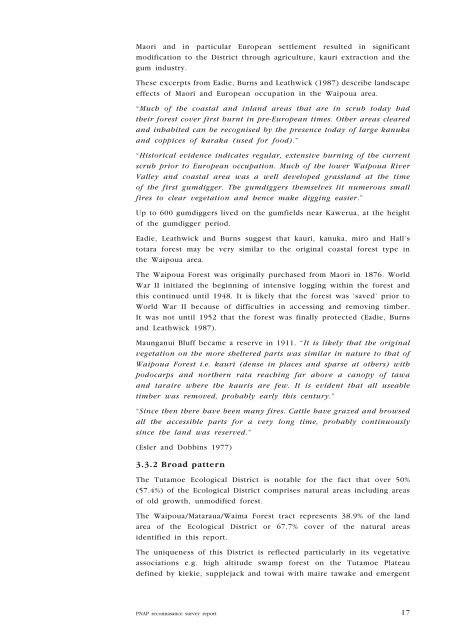Natural areas of Tutamoe Ecological District (3. Ecological character)
Natural areas of Tutamoe Ecological District (3. Ecological character)
Natural areas of Tutamoe Ecological District (3. Ecological character)
Create successful ePaper yourself
Turn your PDF publications into a flip-book with our unique Google optimized e-Paper software.
Maori and in particular European settlement resulted in significant<br />
modification to the <strong>District</strong> through agriculture, kauri extraction and the<br />
gum industry.<br />
These excerpts from Eadie, Burns and Leathwick (1987) describe landscape<br />
effects <strong>of</strong> Maori and European occupation in the Waipoua area.<br />
“Much <strong>of</strong> the coastal and inland <strong>areas</strong> that are in scrub today had<br />
their forest cover first burnt in pre-European times. Other <strong>areas</strong> cleared<br />
and inhabited can be recognised by the presence today <strong>of</strong> large kanuka<br />
and coppices <strong>of</strong> karaka (used for food).”<br />
“Historical evidence indicates regular, extensive burning <strong>of</strong> the current<br />
scrub prior to European occupation. Much <strong>of</strong> the lower Waipoua River<br />
Valley and coastal area was a well developed grassland at the time<br />
<strong>of</strong> the first gumdigger. The gumdiggers themselves lit numerous small<br />
fires to clear vegetation and hence make digging easier.”<br />
Up to 600 gumdiggers lived on the gumfields near Kawerua, at the height<br />
<strong>of</strong> the gumdigger period.<br />
Eadie, Leathwick and Burns suggest that kauri, kanuka, miro and Hall’s<br />
totara forest may be very similar to the original coastal forest type in<br />
the Waipoua area.<br />
The Waipoua Forest was originally purchased from Maori in 1876. World<br />
War II initiated the beginning <strong>of</strong> intensive logging within the forest and<br />
this continued until 1948. It is likely that the forest was ‘saved’ prior to<br />
World War II because <strong>of</strong> difficulties in accessing and removing timber.<br />
It was not until 1952 that the forest was finally protected (Eadie, Burns<br />
and Leathwick 1987).<br />
Maunganui Bluff became a reserve in 1911. “It is likely that the original<br />
vegetation on the more sheltered parts was similar in nature to that <strong>of</strong><br />
Waipoua Forest i.e. kauri (dense in places and sparse at others) with<br />
podocarps and northern rata reaching far above a canopy <strong>of</strong> tawa<br />
and taraire where the kauris are few. It is evident that all useable<br />
timber was removed, probably early this century.”<br />
“Since then there have been many fires. Cattle have grazed and browsed<br />
all the accessible parts for a very long time, probably continuously<br />
since the land was reserved.”<br />
(Esler and Dobbins 1977)<br />
<strong>3.</strong><strong>3.</strong>2 Broad pattern<br />
The <strong>Tutamoe</strong> <strong>Ecological</strong> <strong>District</strong> is notable for the fact that over 50%<br />
(57.4%) <strong>of</strong> the <strong>Ecological</strong> <strong>District</strong> comprises natural <strong>areas</strong> including <strong>areas</strong><br />
<strong>of</strong> old growth, unmodified forest.<br />
The Waipoua/Mataraua/Waima Forest tract represents 38.9% <strong>of</strong> the land<br />
area <strong>of</strong> the <strong>Ecological</strong> <strong>District</strong> or 67.7% cover <strong>of</strong> the natural <strong>areas</strong><br />
identified in this report.<br />
The uniqueness <strong>of</strong> this <strong>District</strong> is reflected particularly in its vegetative<br />
associations e.g. high altitude swamp forest on the <strong>Tutamoe</strong> Plateau<br />
defined by kiekie, supplejack and towai with maire tawake and emergent<br />
PNAP reconnasance survey report<br />
17

















